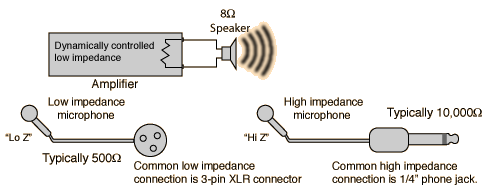Impedance Matching
In the early days of high fidelity music systems, it was crucial to pay attention to the impedance matching of devices since loudspeakers were driven by output transformers and the input power of microphones to preamps was something that had to be optimized. The integrated solid state circuits of modern amplifiers have largely removed that problem, so this section just seeks to establish some perspective about when impedance matching is a valid concern.
As a general rule, the maximum power transfer from an active device like an amplifier or antenna driver to an external device occurs when the impedance of the external device matches that of the source. That optimum power is 50% of the total power when the impedance of the amplifier is matched to that of the speaker. Improper impedance matching can lead to excessive power use, distortion, and noise problems. The most serious problems occur when the impedance of the load is too low, requiring too much power from the active device to drive the load at acceptable levels. On the other hand, the prime consideration for an audio reproduction circuit is high fidelity reproduction of the signal, and that does not require optimum power transfer.
In modern electronics, the integrated circuits of an amplifier have at their disposal hundreds to thousands of active transistor elements which can with appropriate creative use of feedback make the performance of the amplifier almost independent of the impedances of the input and output devices within a reasonable range.
On the input side, the amplifier can be made to have almost arbitrarily high input impedance, so in practice a microphone sees an impedance considerably higher than its own impedance. Although that does not optimize power transfer from the microphone, that is no longer a big issue since the amplifier can take the input voltage and convert it to a larger voltage - the term currently used is "bridging" to a larger image of the input voltage pattern.
On the output side, a loudspeaker may still have a nominal impedance of something like 8 ohms, which formerly would have required having an amplifier output stage carefully matched to 8 ohms. But now with the active output circuitry of audio amplifiers, the effective output impedance may be very low. The active circuitry controls the output voltage to the speaker so that the appropriate power is delivered.

| Microphone impedance matching | Amplifier impedance matching |
Sound reproduction concepts
| HyperPhysics***** Sound | R Nave |




